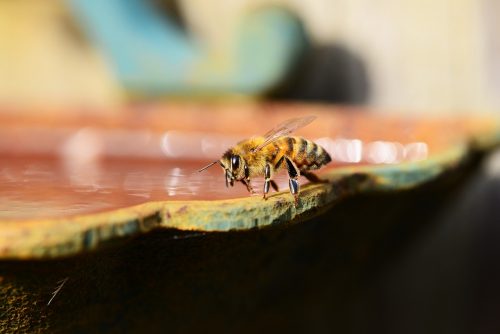Image courtesy of Needpix.
Can a honeybee swim? In a recent paper, California Institute of Technology research engineer Chris Roh and professor Morteza Gharib found that honeybees transform their wings into “hydrofoils” after falling into water. Though optimized for flight, the wings can also beat the water if required, creating a small thrust to nudge the bee ashore. This resembles preflight motion, and honeybee wing adaptability could also inspire future aerial-aquatic vehicles.
Roh and Gharib were first inspired when they watched honeybees flounder on the surface of a lake in California. Insect wings stop generating lift once in contact with a fluid surface. What’s worse, water’s increased density and colder temperature make motion more difficult. Thus, the honeybee’s water surface motion surprised Roh and Gharib. Recognizing that the bee likely used its wings differently in water, they analyzed the flow patterns around a honeybee with shadowgraphs and particle seeding methods. This proved that the water imparts a tiny forward momentum to the honeybee. Yet powering the water returns much less force to the bee than aerodynamic lift—nearly two orders smaller. From high speed videos, researchers concluded the honeybee lost significant momentum in its wing’s “recovery stroke.”
“Instead of propelling by dragging the wing, like our swimming, honeybees pull on the water surface upward to propel,” Roh said. Since this accelerated current then pushes against the bee, efficiency is lowered.
To repeat their observations with a steady, adjustable setup, Roh and Gharib constructed a miniature wing to mimic a honeybee’s wing. By moving the mechanical wing at thirty times a second and calculating the momenta, Roh and Gharib found that added mass (an unsteady, inertial force) generates oscillations in the bee’s acceleration. A more complex analysis would involve the interaction between the water and the body of the honeybee, given the honeybee generates waves that diffract and reflect along its body. “During the analysis we assumed that the thruster (wing) and body interaction is small. This is something we still have to study further in the future,” Roh said.
Biologically, this study sheds light on a newly observed form of insect-water surface biolocomotion. Many other so-called “water walking” insects have thin, hydrophobic legs which rely on surface tension to keep the insect moving. Other fully submerged insects like the whirligig beetle use drag-based propulsion (a steady, inertial force) like swimming “doggy style.” For the honeybee, unsteady inertial force is dominant. The honeybee likely benefits from its “lifeboat,” particularly in the summer when they fly over water more often, which increases their chances of falling into a pond. Roh and Gharib also speculate that early preflight locomotion may bear resemblances to the motion studied here. While the honeybee itself likely did not develop flight from water surface motion, this type of inefficient, yet workable, propulsion holds clues to the earliest instances of preflight insects.
Nature’s creations continue to surprise us. This study provides a fascinating glimpse into the versatility of honeybee wings, working even in water to propel the honeybee forward. Future applications may include robotic vehicles that work both above and on the water surface. These would have to be small, since the added mass effect does not scale well, but mimicking honeybee wings can potentially reduce mechanical complexity in designing a single aerial-aquatic propulsion system.

